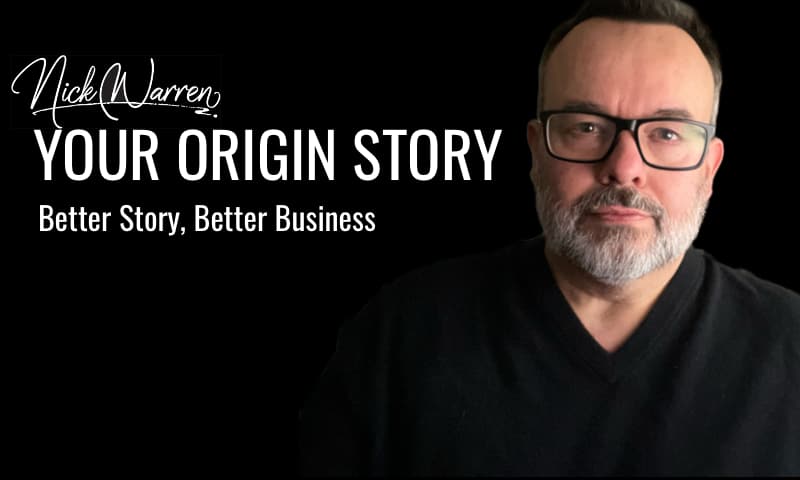As I’ve said elsewhere, my first business grew without any real selling of any kind. We grow from a one-idiot firm who didn’t understand pricing, to an agency with clients around the world.
The secret to that growth is entirely captured in this page. The stories we were telling through our words and actions created a culture, the culture created a business and our clients became our sales team.
It’s a lovely way to build a business … and it’s exactly what I am doing here.
But enough from me, because …
What you say isn’t nearly as important as what others say about you.
This Is Marketing: You Can’t Be Seen Until You Learn To See (2018) – Seth Godin
IF you hope to sell a product or service or candidate or organization that affects the way people feel, AND IF you hope to get a premium (in revenue or in market share or in votes) for that feeling …
THEN you must refocus your efforts. Concentrate on the story you tell. The story you tell affects the way your audience feels about the product. The story, when you come right down to it, is the product.
SOME CONSUMERS will avoid or resist or deny your story. That’s okay. Tell your story to people who want to hear it, who want to believe it, who will tell their friends.
BEFORE you begin to tell your story you have no choice but to live that story. To make it authentic. Every action you take and every signal you send has to be in support of the story.
FINALLY, realize that you are in a powerful position and use that power to do the right thing, to tell the whole truth and to spread ideas worth spreading.
This Is Marketing: You Can’t Be Seen Until You Learn To See (2018) – Seth Godin
Bernadette Jiwa has written half a dozen extraordinary books that humanize the too-often industrialized craft of marketing.
In Story Driven, she makes it clear that if we merely try to fill a hole in the market, we’re doomed to a cycle of rearview-mirror behavior. We’re nothing but a commodity in the making, always wary of our competition. We have no choice but to be driven by scarcity, focused on maintaining or perhaps slightly increasing our market share.
The alternative is to find and build and earn your story, the arc of the change you seek to produce. This is a generative posture, one based on possibility, not scarcity.
Now that you’ve chosen your audience, where do you want to take them? Bernadette shares ten things that good stories do; if the story you’re telling yourself (and others) doesn’t do these things for you, you might need to dig deeper and find a better story, one that’s more true and more effective.
Good Stories:
- Connect us to our purpose and vision for our career or business.
- Allow us to celebrate our strengths by remembering how we got from there to here.
- Deepen our understanding of our unique value and what differentiates us in the marketplace.
- Reinforce our core values.
- Help us to act in alignment and make value-based decisions.
- Encourage us to respond to customers instead of react to the marketplace.
- Attract customers who want to support businesses that reflect or represent their values.
- Build brand loyalty and give customers a story to tell.
- Attract the kind of like-minded employees we want.
- Help us to stay motivated and continue to do work we’re proud of.
This Is Marketing: You Can’t Be Seen Until You Learn To See (2018) – Seth Godin
Marshall Ganz is the brilliant Harvard professor who has worked both with Cesar Chavez and Barack Obama.
He has articulated a simple three-step narrative for action: the Story of Self, the Story of Us, and the Story of Now.
The Story of Self gives you standing, a platform from which to speak. When you talk about your transition—from who you used to be to who you became—you are being generous with us. It’s not about catastrophizing your situation or the faux empathy of online vulnerability. Instead, the story of self is your chance to explain that you are people like us. That you did things like this. That your actions led to a change, one we can hear and see and understand.
The Story of Us is the kernel of a Tribe. Why are we alike? Why should we care? Can I find the empathy to imagine that I might be in your shoes
The story of us is about together, not apart. It explains why your story of self is relevant to us, and how we will benefit when we’re part of people like us.
And the Story of Now is the critical pivot. The story of now enlists the tribe on your journey. It’s the peer opportunity/peer pressure of the tribe that will provide the tension for all of us to move forward, together.
I was like you. I was in the desert. Then I learned something and now I’m here. Of course, I am not alone. I did not do this alone and I see in you the very pain I saw in myself. Together, we can make this better. But if we hesitate, or if we leave the others behind, it won’t work. The urgency of now requires that we do it together, without delay, without remorse, without giving in to our fear.
Story of self > Story of us > Story of now.
Here’s a simple example:
“I used to be fifty pounds overweight. My health was in tatters and my relationships were worse. Then I discovered competitive figure skating. It was tough at first, but thanks to my new friends on the rink, I got to the point where it was fun. Within months, I had lost dozens of pounds, but more important, I felt good about myself. “The real win for me, though, was the friendships I made. I discovered that not only did I feel terrific physically, but being out on the ice with people—old friends like you, and the new ones I made at the rink—made me feel more alive. “I’m so glad you were willing to come to the rink today. I called ahead and they’ve reserved some rental skates for you …”
In the first paragraph, we hear the story of our friend, a narrative of going from here to there. In the second, we hear about how it changes our friend’s relationships, including to people like us. And in the third, there’s a call to action, a reason to do something right now.
This Is Marketing: You Can’t Be Seen Until You Learn To See (2018) – Seth Godin
We mostly focus on telling stories to others, but there’s an even more valuable audience closer to home:
Self-Marketing Might Be the Most Important Kind Stoicism
What story do you tell yourself about yourself? I know that marketers tell stories. We tell them to clients, prospects, bosses, suppliers, partners, and voters. If the stories resonate and spread and seduce, then we succeed. But what about the story you tell yourself?
Do you have an elevator pitch that reminds you that you’re a struggling fraud, certain to be caught and destined to fail? Are you marketing a perspective and an attitude of generosity? When you talk to yourself, what do you say? Is anyone listening? You’ve learned through experience that frequency works. That minds can be changed. That powerful stories have impact. I guess, then, the challenge is to use those very same tools on yourself.
Whatcha Gonna Do with That Duck?: And Other Provocations (2013) – Seth Godin
See Also:
On Attention | On Authenticity | On Average | On Challenging Yourself | On Storytelling | On Your Story | On Tension | On True Lies
Or choose a path towards stories that mean business.

Explore the art and science of business storytelling. The rabbit hole goes way deeper than you think.

The Business Storytelling Glossary lists the concepts, ideas and definitions that use in my work. Your mileage will vary.

